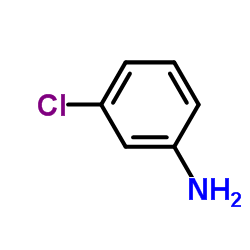3-Chloroaniline

3-Chloroaniline structure
|
Common Name | 3-Chloroaniline | ||
|---|---|---|---|---|
| CAS Number | 108-42-9 | Molecular Weight | 127.572 | |
| Density | 1.2±0.1 g/cm3 | Boiling Point | 227.8±13.0 °C at 760 mmHg | |
| Molecular Formula | C6H6ClN | Melting Point | −11-−9 °C(lit.) | |
| MSDS | Chinese USA | Flash Point | 123.9±0.0 °C | |
| Symbol |



GHS06, GHS08, GHS09 |
Signal Word | Danger | |
|
cIEF for rapid pKa determination of small molecules: a proof of concept.
Eur. J. Pharm. Sci. 63 , 14-21, (2014) A capillary isoelectric focusing (cIEF) method was developed for the determination of the ionization constants (pKa) of small molecules. Two approaches used to decrease the electroosmotic flow (EOF) were compared: (i) a hydroxypropylcellulose (HPC) coated cap... |
|
|
Calculating virtual log P in the alkane/water system (log P(N)(alk)) and its derived parameters deltalog P(N)(oct-alk) and log D(pH)(alk).
J. Med. Chem. 48 , 3269-79, (2005) Growing interest in the use of both the logarithm of the partition coefficient of the neutral species in the alkane/water system (log P(N)(alk)) and the difference between log P(N)(oct) (the logarithm of the partition coefficient of the neutral species in the... |
|
|
QSAR study on permeability of hydrophobic compounds with artificial membranes.
Bioorg. Med. Chem. 15 , 3756-67, (2007) We previously reported a classical quantitative structure-activity relationship (QSAR) equation for permeability coefficients (P(app-pampa)) by parallel artificial membrane permeation assay (PAMPA) of structurally diverse compounds with simple physicochemical... |
|
|
Dissipation of triclosan, triclocarban, carbamazepine and naproxen in agricultural soil following surface or sub-surface application of dewatered municipal biosolids.
Sci. Total Environ. 512-513 , 480-8, (2015) In many jurisdictions land application of municipal biosolids is a valued source of nutrients for crop production. The practice must be managed to ensure that crops and adjacent water are not subject to contamination by pharmaceuticals or other organic contam... |
|
|
Biodegradation of 2-chloroaniline, 3-chloroaniline, and 4-chloroaniline by a novel strain Delftia tsuruhatensis H1.
J. Hazard. Mater. 179(1-3) , 875-82, (2010) A new strain Delftia tsuruhatensis H1 able to degrade several chloroanilines (CAs) as individual compounds or a mixture was isolated from a CA-degrading mixed bacterial culture. The isolated strain could completely degrade 3-CA and 4-CA as growth substrates, ... |
|
|
Two-step hollow fiber-based, liquid-phase microextraction combined with high-performance liquid chromatography: a new approach to determination of aromatic amines in water.
J. Chromatogr. A. 1082(2) , 136-42, (2005) A novel method for the extraction of aromatic amines present in water samples is produced here coupling two-step liquid-phase microextraction with high performance liquid chromatography by using a monolithic column. The hydrophobic porous polypropylene membra... |
|
|
In vivo and in vitro nephrotoxicity of aniline and its monochlorophenyl derivatives in the Fischer 344 rat.
Toxicology 38(3) , 269-83, (1986) Aniline (A) and its monochlorophenyl derivatives (2-CA, 3-CA and 4-CA) are widely-used chemical intermediates. In the present study, the in vivo and in vitro nephrotoxic potential of these compounds was assessed in Fischer 344 rats. In the in vivo experiments... |
|
|
Bioaugmentation of activated sludge towards 3-chloroaniline removal with a mixed bacterial population carrying a degradative plasmid
Bioresour. Technol. 100(12) , 2902-9, (2009) A bioaugmentation approach combining several strategies was applied to achieve degradation of 3-chloroaniline (3CA) in semicontinuous activated sludge reactors. In a first step, a 3CA-degrading Comamonas testosteroni strain carrying the degradative plasmid pN... |
|
|
The utilization of aniline, chlorinated aniline, and aniline blue as the only source of nitrogen by fungi in water.
Water Res. 35(5) , 1219-24, (2001) The ability of fungi to degrade aniline and its derivatives in water is reported. Several fungi are able to degrade aniline and its derivatives as a sole nitrogen, carbon and energy source. Some of these fungi were obtained from activated sludge by enrichment... |
|
|
Biotransformation of monochloroanilines in guppy, Poecilia reticulata.
Xenobiotica 24(1) , 59-69, (1994) 1. Guppies (Poecilia reticulata) were exposed for 96 h to 4-chloroaniline (4CA), 3-chloroaniline (3CA) and 2-chloroaniline (2CA) in a static exposure system. 4-Chloroacetanilide (N4CA), 3-chloroacetanilide (N3CA), and 2-chloroacetanilide (N2CA) were identifie... |